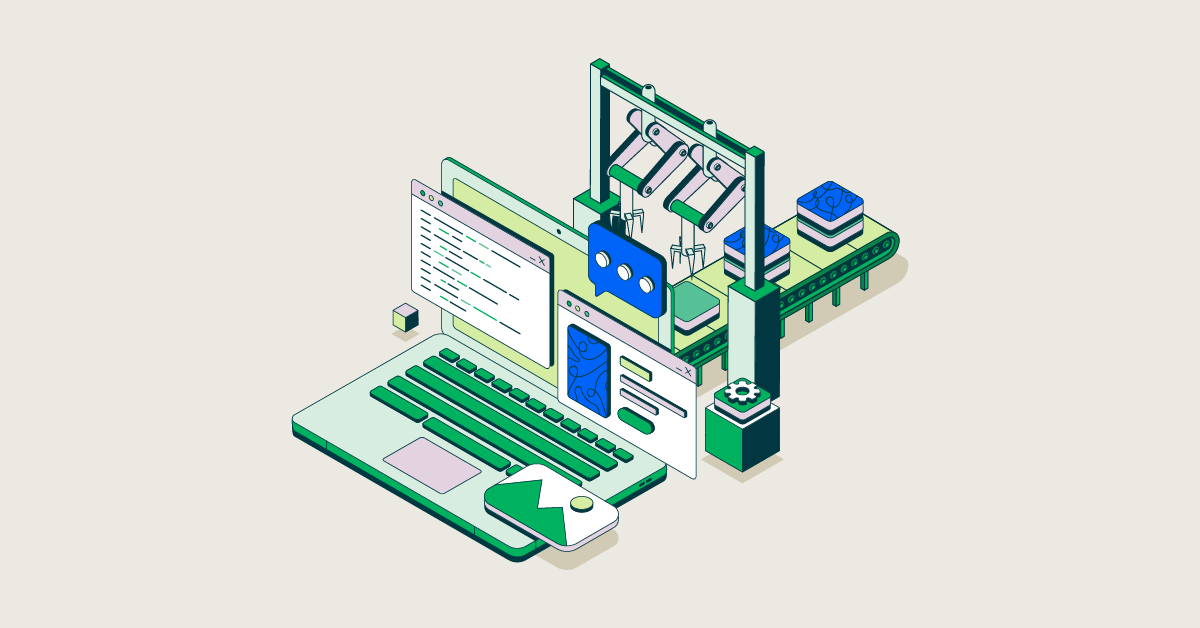What is personalization in customer experience
Magnolia in just 12 minutes
Why not learn more about what Magnolia can do while you have a coffee?
Customers have higher than ever expectations from brands and one of them is personalized experiences. Brand’s approach to personalization evolved from mass marketing strategies to more nuanced tactics that focus on understanding and predicting customer behaviour as customers gravitate more and more toward brands that make them feel understood as individuals.
Personalization strategies now consider a wide array of customer data points but to analyse, understand, and transform them into valuable input, brands turn to digital experience platforms(DXPs), like Magnolia, that can significantly simplify the process and provide valuable support.
The benefits of crafting experiences that cater to the individual preferences of consumers are clear: 67% spend more money when personalization reflects an understanding of them and anticipates their needs.
Everyone loves a personalized experience. We all want to feel like the products and services we encounter are made exclusively for us. From receiving relevant product recommendations to enjoying customized news feeds with dynamic content, personalization has transformed how we interact with technology, making our digital journeys more captivating and meaningful.
In this article, we will delve deeply into the concept of personalization, exploring its significance not only for modern consumers but also for the success of your business. We will uncover the essential elements of effective personalization, address the challenges and ethical considerations surrounding its implementation, and present you with actionable strategies to seamlessly integrate personalization into your business model.
What is personalization?
Personalization refers to the practice of customizing experiences, content, products, or services to meet the specific preferences and needs of individual customers. It involves leveraging data and technology to deliver targeted and relevant interactions, making customers feel valued.

This can manifest in various ways, such as personalized product recommendations on ecommerce websites, customized content in social media feeds, individualized email marketing campaigns, or personalized user interfaces in mobile apps.
Why is personalization important?
Treating customers as unique individuals and understanding their needs is a great way to measure business success. Here are some significant reasons why personalization is important.
Enhanced user experience – 84% of consumers emphasized the importance of brands providing consistent, positive interactions across touchpoints, Deloitte’s Digital research shows. By embracing personalization, you can create a more engaging and satisfying user experience, increasing the chances of customers staying on your website, exploring further, and making purchases.
Improved customer satisfaction – Relevant content, personalized recommendations, and streamlined user journeys make customers feel valued and appreciated. By anticipating their needs, offering choices, and providing tailored support, you can reduce information overload and build emotional connections, fostering customer loyalty, positive word-of-mouth referrals, and higher customer lifetime value. A survey by Deloitte revealed that brands that excel in personalization have a customer satisfaction of 57% compared to businesses that “struggle to find the right balance in their personalization strategies and tactics” thatthat that report a percentage of only 29.
Increased conversions and revenue – By customizing experiences, product recommendations, and offers to match individual customer preferences, in other words taking the experience-driven commerce approach, you create a more captivating and relevant shopping experience. This increases the likelihood of converting visitors into paying customers and encourages repeat purchases. Nearly 3 in 4 consumers spend 37% more on brands that deliver personalized experiences, as Deloitte’s Digital report shows.
Competitive advantage – Embracing personalization as a core part of your business enables you to stay ahead in a crowded digital marketplace. You can make informed business decisions and innovate marketing strategies using data-driven insights. This allows you to attract and retain customers while building a distinct brand identity.
Elements of personalization
Numerous factors come together to elevate user experience, boost customer satisfaction, drive conversions, and set your business apart.

These factors of personalization can be categorized into four key elements, listed below.
Web personalization
Web personalization involves leveraging customer data to create a more engaging user experience on web platforms. You can gain valuable insights into your visitors by analyzing browsing behavior and preferences. Utilizing this data, you can customize website content, banners, and recommendations to match each visitor's interests and needs. Real-time triggers, like pop-ups, can be implemented to respond to specific user actions and provide relevant information.
Personalizing page content, product recommendations, call to actions (CTAs), and user interfaces according to individual preferences also helps reduce bounce rates and ensures relevant experiences for your users. The ultimate goal is to create personalized web experiences that adapt seamlessly across various devices, from mobile to desktop and even IoT devices.
Content personalization
Content personalization involves delivering personalized content to users based on their interests, preferences, and past interactions. It includes providing personalized articles, blog recommendations, and curated content to engage users effectively. By analyzing users' search history, you can offer relevant content that aligns with their specific interests and needs.
Brands must create not only personalized content but compelling content that matches the customer's deal stage to enhance the entire experience. In today’s digital landscape, consumers expect technology-driven personalization from the initial interaction to post-purchase engagement, all aligned with their individual preferences.
To implement content personalization successfully, audience segmentation is crucial. Segmenting your target audience based on common characteristics, interests, and behaviors enables you to craft personalized messages that address each audience segment's specific needs and pain points, enhancing user engagement and satisfaction.
Moreover, customizing content formats such as blog posts, videos, and infographics to suit the preferences of different audience groups ensures a more engaging and resonant user experience. Conducting A/B testing helps you experiment with various content variations to determine which resonates best with each segment, allowing you to optimize your content strategy accordingly.
Ecommerce personalization
Ecommerce personalization focuses on enhancing the shopping experience for customers. Through personalized product recommendations based on previous purchases, customers receive suggestions that align with their specific tastes and interests. Additionally, dynamic pricing allows you to offer customized discounts or pricing based on customer behavior and loyalty. You can drive conversion rates and increase sales by providing targeted promotions and special deals to specific customer segments.
Furthermore, ecommerce personalization includes cart abandonment recovery, where personalized emails or notifications are sent to remind customers about abandoned shopping carts, encouraging them to complete their purchases. This seamless and personalized customer journey ensures that each step of the shopping process caters to the individual's unique needs, maximizing satisfaction and engagement.
The ability to customize product recommendations, pricing, and offers sets your business apart in the competitive market, cultivating a loyal customer base and ultimately contributing to long-term business success.
Marketing personalization
In marketing personalization, digital marketers and business owners leverage customer data to deliver personalized communication and campaigns. You can create detailed customer profiles by analyzing data from various sources like purchase history, browsing behavior, and social media engagement. These profiles help your marketing team create and provide relevant experiences to different customer segments.
Tailoring marketing efforts to each customer's preferred channels, such as email, social media, or SMS, ensures that your messages reach them effectively. Additionally, mapping out customer journeys helps identify opportunities for personalized touchpoints throughout the buying process, enabling you to deliver relevant content and offers at each stage. Marketing personalization also extends to customer service and loyalty campaigns, enhancing customer satisfaction and resonance.
Blueprints for Deep Personalization
Personalization blueprints that lay the foundation for marketers and developers to collaborate with each other and build personalized experiences.
Challenges and considerations
Personalizing experiences for each customer is a complex task due to regulatory constraints and data management challenges. A survey by Gartner shows that about two-thirds of digital marketing leaders still struggle to achieve personalization. However, overcoming these challenges is possible with the right approach and strategy. Here are some common challenges and tips to overcome them:
Data privacy and security
Personalization relies on collecting and analyzing user data to deliver tailored experiences, but many consumers worry about their data being collected without permission. Building trust is crucial, and using first-party data obtained directly from your users is preferable to third-party data, as it fosters transparency and ensures user consent.

Striking the right balance between personalization and data privacy is essential. By prioritizing ethical data practices, complying with privacy regulations, being transparent with users, using first-party data, and implementing robust security measures to safeguard user information, you can navigate these challenges, strengthen customer relationships, and deliver personalized experiences that resonate with your audience while respecting their privacy concerns.
Filter bubbles and diverse perspectives
Filter bubbles occur when users are exposed only to information that aligns with their existing beliefs and preferences. While this might boost short-term user engagement and satisfaction, it can reinforce existing biases and restrict users from accessing diverse insights and knowledge over time.

Diverse perspectives are essential for fostering critical thinking, informed decision-making, and well-rounded experiences for users. By curating content that exposes users to different viewpoints and leveraging AI algorithms that offer varied suggestions, you can mitigate the filter bubble effect and promote a more open and inclusive user experience.
Complex personalization efforts
Setting up personalization tools and processes can be quite complex. It requires careful planning, technical expertise, and a deep understanding of customer data management. However, adopting a digital experience platform (DXP) like Magnolia can significantly simplify the process and provide valuable support.

Magnolia is a composable solution that allows you to integrate various tools and functionalities required for personalization. It streamlines the implementation process by offering a unified platform where you can manage content, customer data, and personalized experiences all in one place. It also provides user-friendly tools and intuitive interfaces that minimize the need for extensive technical expertise, so you can focus more on delivering exceptional customer experiences and driving business growth.
Strategies for successful personalization
In 2024, personalization leaders expect a 46% increase in marketing budgets devoted to personalization and a total of 60% of the entire marketing budget to be allocated to this segment. A data-driven strategy with clear goals and a specific roadmap, including audience segmentation and optimization, is essential to succeed.

Here are some strategies for successful personalization implementation:
Data-driven approach
Data-driven personalization involves collecting and analyzing user data to understand their behaviors, preferences, and needs. To implement this approach effectively, consider utilizing customer data platforms. These platforms offer efficient data management, enabling you to organize and analyze the data in a structured manner, leading to more informed decision-making.
Transparency and honesty with data usage are essential components of a data-driven approach. Building trust with your customers is vital, so be upfront about how you collect and use their data. Consider using first-party data collected directly from customer interactions with your websites, app, and other platforms. It provides accurate and up-to-date information, making it a valuable resource for personalization efforts.
Automation and artificial intelligence (AI)
The power of automation lies in its ability to streamline processes efficiently. Marketing automation tools can handle repetitive tasks, saving time and resources, while AI algorithms can analyze vast amounts of data in real time. This analysis helps identify user behaviors, preferences, and patterns, enabling you to make data-driven, personalized recommendations and decisions.
Furthermore, AI-powered algorithms continuously learn from user interactions, allowing for dynamic adjustments to improve the accuracy and effectiveness of personalization over time. As a result, you can stay ahead of customer needs and preferences, ensuring your business remains competitive in a rapidly evolving market.
Testing and optimization
Testing and optimization are essential to fine-tune and enhance personalized experiences. Conducting A/B tests enable you to determine the most effective approach for your audience and make necessary adjustments over time.
You can also gain valuable insights into your customers' preferences, needs, and challenges through user feedback. By attentively considering customer opinions and suggestions, you can better understand their expectations and customize your personalization strategies accordingly.
By implementing A/B testing, gathering user feedback, and refining your approaches for different customer segments, you can deliver more relevant and meaningful customer experiences.
Generational personalization
Brands have the power to captivate multiple generations. Still, despite overlapping data points like common interests (they all want the same product) or geolocation, the message that resonates can vary among them.
Millennials are known as the most demanding generation when it comes to personalization. They expect a holistic, individualized experience from brands when it comes to either services or products. On the other hand, Baby Boomers expect product recommendations through trusted digital retailers and respond better to this approach than a personalized customer journey.
When tailoring experiences for Gen Z, it's essential for brands to understand and align with their values of authenticity and fulfilling a mission. This understanding can guide brands in creating authentic connections with this generation. With Gen Xers, deals and personalization through e-mails work the best.
User-centric design
User-centric design, also known as user-centered design, is an approach to product and experience development that prioritizes the user's needs, preferences, and expectations. It involves putting the user at the center of the design process, focusing on understanding their behaviors, goals, and pain points to create products, services, or experiences that are intuitive, accessible, and enjoyable.
When designing marketing strategies, focus on being helpful rather than invasive. Customers appreciate personalized content and recommendations that add value to their experience rather than feeling like they are being intruded upon.
Conclusion
Personalization is a powerful strategy that can transform how you engage with your customers and drive business success. By delivering tailored experiences, personalized product recommendations, and relevant content, you can create a more engaging and satisfying user experience. Improved customer satisfaction and increased conversions and revenue are just some of the benefits that personalization offers.
To successfully implement personalization, consider adopting a data-driven approach, leveraging automation and AI, conducting A/B testing, and embracing user-centric design. With the right strategies, you can provide meaningful and individualized experiences that will set your business apart and foster long-lasting customer loyalty.
Ready to take your personalization efforts to the next level? Download our whitepaper — Blueprints for Deep Personalization — to unlock the full potential of this game-changing strategy.








